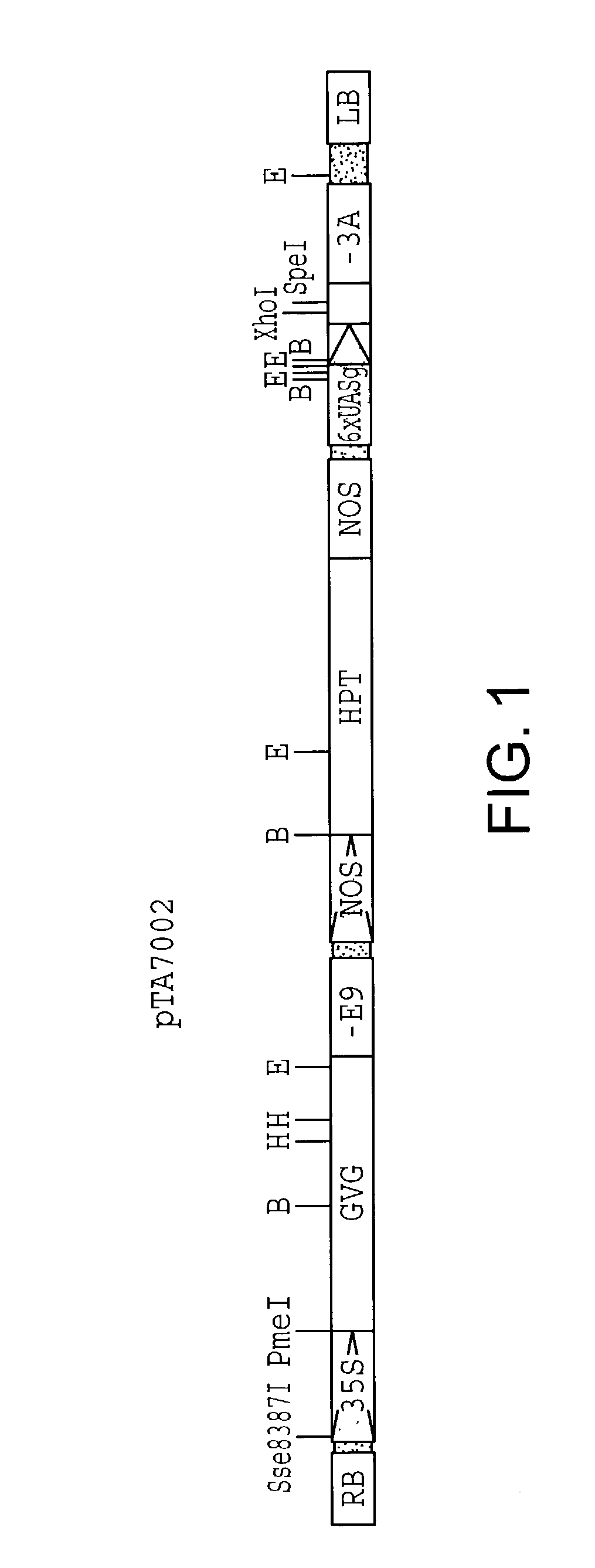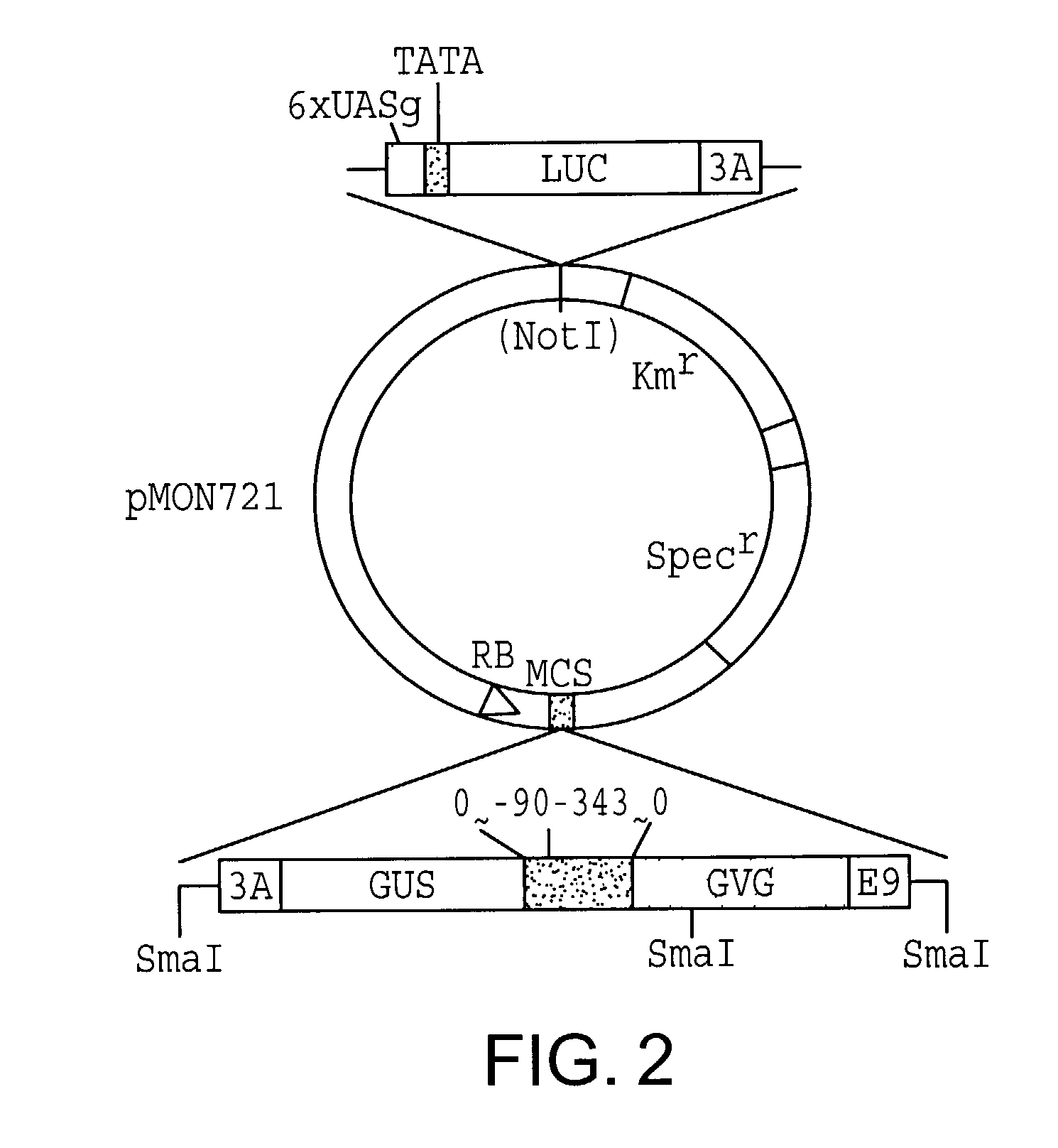Chemical inducible promoters used to obtain transgenic plants with a silent marker
a technology of silent marker and promoter, which is applied in the field of chemical inducible promoters used to obtain transgenic plants with silent markers, can solve the problems of inability to root, difficult to separate the transformed and untransformed cells or tissues, and difficulty in separating transgenic plants. and losing apical dominance, etc., to achieve high efficiency and increase the endogenous level of cytokinin
- Summary
- Abstract
- Description
- Claims
- Application Information
AI Technical Summary
Benefits of technology
Problems solved by technology
Method used
Image
Examples
example 1
DNA Constructs
A) Construct pTA7002
[0061]Plasmid pTA7002 is similar to pBI101 (Clontech) except that the sequence between the right border and the left border is replaced by three transcription units. The insert between the right and left borders of pTA7002 is illustrated in FIG. 1 and comprises a plasmid which includes the following elements: a 35S promoter, a GAL4 DNA binding domain, a VP 16 transactivating domain, the glucocorticoid receptor regulatory domains and a pea ribulose bisphosphate carboxylase small subunit rbcS-E9 poly(A) addition sequence all as part of a first transcription unit (35S-GVG-E9); a nopaline synthase (NOS) promoter, hygromycin phosphotransferase coding sequence, and the NOS terminator as part of a second transcription unit (NOS-HPT-NOS); and 6 tandem copies of a GAL4 upstream activating sequence (UAS) placed upstream of a minimal 35S promoter (−46 to +8) including the TATA region as part of a third transcription unit (6xUAS-(−46 / 35S)-3A). This third transc...
example 2
Plants Transformed with pMON721 Based Vectors
[0086]The vector pMON721 can be used in combination with A. tumefaciens strain ABI but is not used with A. tumefaciens strain LB4404. Strain ABI alone can induce shoots on tobacco leaf discs cultivated on MS medium without hormone and is therefore unusable for experiments in which the marker is the growth of shoots. The pMON721-A. tumefaciens strain ABI combination is useful for those experiments in which other markers are being screened, e.g., when one is selecting for antibiotic resistance. In these experiments the cells are grown in medium with hormones and selection is by kanamycin resistance, and they are grown both in the presence and in the absence of the inducer, e.g., dexamethasone.
A) Transformation of Plasmid into Bacteria
[0087]Plasmids were introduced into Agrobacterium tumefaciens. Plasmids derived from pMON721 were placed into strain ABI (Monsanto Corp., St. Louis, Mo.) by methods well known by those of skill in the art. For ...
example 3
Plants Transformed with PTA7002 or PTA7001 Based Vectors
[0090]The vectors pTA7002 and pTA7001 may be used with A. tumefaciens strain LB4404. Unlike A. tumefaciens strain ABI, the LB4404 strain does not induce shoots and this combination of vector and bacterial strain may be used in those experiments in which the growth of shoots is the marker. The experiments described here used pTA7002 / ipt. However, the vector used may include other genes of interest which are not under the control of the GVG system, which other genes it is desired to transform into plants. In these experiments, plants are selected on medium without hormones and without antibiotics, but in the presence and in the absence of inducer (e.g., dexamethasone). Only those cells grown in the presence of the inducer should generate shoots. These shoots are cut, placed in medium with auxins but without the inducer. The absence of the inducer stops the transcription of the ipt gene and auxin in the medium promotes root regene...
PUM
| Property | Measurement | Unit |
|---|---|---|
| time | aaaaa | aaaaa |
| temperature | aaaaa | aaaaa |
| length | aaaaa | aaaaa |
Abstract
Description
Claims
Application Information
 Login to View More
Login to View More - R&D
- Intellectual Property
- Life Sciences
- Materials
- Tech Scout
- Unparalleled Data Quality
- Higher Quality Content
- 60% Fewer Hallucinations
Browse by: Latest US Patents, China's latest patents, Technical Efficacy Thesaurus, Application Domain, Technology Topic, Popular Technical Reports.
© 2025 PatSnap. All rights reserved.Legal|Privacy policy|Modern Slavery Act Transparency Statement|Sitemap|About US| Contact US: help@patsnap.com



